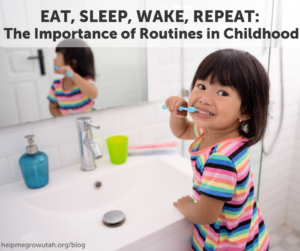 Every morning is the same. Wake up. Eat breakfast. Get dressed. Brush your teeth. It may feel like you are in a cycle of doing the same thing every day, but according to zerotothree.org, having a daily routine for your child can help them build brain power and help support good mental health. For the free spirit, routines may seem too rigid, but there are ways to have a solid routine and also keep it flexible. Routines can come in any shape or size. There are morning routines, bedtime routines, after-school routines, and everything in between.
Every morning is the same. Wake up. Eat breakfast. Get dressed. Brush your teeth. It may feel like you are in a cycle of doing the same thing every day, but according to zerotothree.org, having a daily routine for your child can help them build brain power and help support good mental health. For the free spirit, routines may seem too rigid, but there are ways to have a solid routine and also keep it flexible. Routines can come in any shape or size. There are morning routines, bedtime routines, after-school routines, and everything in between.
Why should I set up a daily routine?
Consistency and routines help a baby or toddler know what is going to happen next. Routines help children learn self-control. This can help reduce power struggles. Even if it is something that the child doesn’t want to do, if they know it is part of the routine, it can help them cooperate better.
Benefits of having a routine:
- Build trust between a child and an adult.
- Help a child feel in control of their environment.
- Consistent routines help a child feel safe and provide comfort.
- Can reduce power struggles
- Bring you and your child closer together
- Help children develop social skills
- Time management
- Guide positive behavior and safety
- Cope with transitions
What makes a good daily routine?
Well planned –
- Everyone understands their roles.
- Everyone sees that roles are reasonable and fair.
Regular –
Good routines are part of everyday family life. Consistency is important, but there needs to be some flexibility. An example of flexibility is that your child does have to get dressed every day, but they can pick out their own clothes.
Predictable –
Things happen in the same order every time. Everyone knows what to expect throughout the day. You can add some flexibility by saying, “Do you want to get dressed first or brush your teeth first?”
How do I teach routines to my children?
Use visuals: Have you seen those super cute chore charts or routines charts that you can print off? It really helps a child when they have a visual of what is going to happen next. For small children who can’t read yet, use pictures. For older children, you can use words.
Break it down into steps: Your child might be overwhelmed if you send them to clean their whole room by themselves. You can break it into steps by letting them choose if they want to pick up the toys first or the books.
If you are trying to implement new elements into your routine and you are getting a lot of pushback from your child, then start small. Add one new thing at a time. When that becomes a habit, then you can add more. Be consistent. Be firm but loving. In no time, you will have a routine that works for your family.





